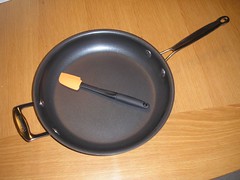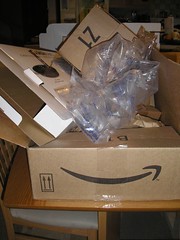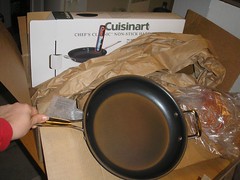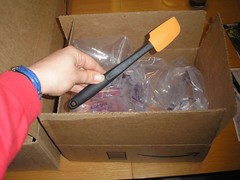Waste: A Photo Essay
I recently ordered myself a new 12-inch non-stick skillet and a mini silicone spatula from Amazon.com. The skillet replaces a ten-year-old skillet whose Teflon coating is finally starting to blister and peel, the spatula replaces a similar spatula whose head detaches from its handle and allows all sorts of gunk to be trapped up inside. I suppose neither are strictly necessary but I didn't feel that I was being entirely frivolous in placing the order, either. I received both items in perfect condition:

What I had not anticipated when placing my order was the amount of packaging that would be involved!

I was really taken aback by the large box and didn't at first even realize what was contained inside. The frying pan manufacturer packed the pan in a sturdy box, wrapped the handles in protective covering, stablized the whole thing with additional cardboard inserts... and then Amazon packed that box inside of an even larger shipping box and packed cushioning material around that.

The spatula was even more ridiculous. Though ordered at the same time and requested to be shipped together, the two items came from different suppliers and so shipped separately. The spatula is literally small enough to fit in about the space of a standard business-size envelope. It actually arrived in a 12" x 9" x 4" box, with the remainder of the space taken up with plastic air pillows and other cushioning or promotional materials.

The whole incident got me thinking. What is the environmental impact of this act of commerce? I can (and do, and will continue to) recycle the cardboard and paper, but not the plastic or foam. Sometimes I save the yards of plastic air pillows that arrive in the various packages I receive to reuse them in packages I send out but I receive far more than I can use or store. What was the cost of shipping those two packages separately? Should I have just gone down to Southcenter or Williams Sonoma and picked the items up in person? What if they didn't have the items I wanted (and surely the local culinary store receives shipments that come in large boxes filled with packing materials, too). I know it sounds like I'm condemning Amazon for its packaging but I do understand that packaging to avoid damages is important to business. In fact, I wouldn't be surprised if this untidy method is actually the less environmentally (and commercially) damaging option when compared to a scenario where using less packaging results in more damages (resulting in more shipping, returns, and damaged goods that then go to waste instead of being put to use). Even so, I find the whole transaction has left me feeling unsettled about my choices. I'm definitely going to care for these new kitchen gadgets to make them last as long as possible (not that I wouldn't have anyway, but I still feel it's worth saying). If I'm going to generate this kind of impact, I'm going to make sure it was as "worth it" as possible.

What I had not anticipated when placing my order was the amount of packaging that would be involved!

I was really taken aback by the large box and didn't at first even realize what was contained inside. The frying pan manufacturer packed the pan in a sturdy box, wrapped the handles in protective covering, stablized the whole thing with additional cardboard inserts... and then Amazon packed that box inside of an even larger shipping box and packed cushioning material around that.

The spatula was even more ridiculous. Though ordered at the same time and requested to be shipped together, the two items came from different suppliers and so shipped separately. The spatula is literally small enough to fit in about the space of a standard business-size envelope. It actually arrived in a 12" x 9" x 4" box, with the remainder of the space taken up with plastic air pillows and other cushioning or promotional materials.

The whole incident got me thinking. What is the environmental impact of this act of commerce? I can (and do, and will continue to) recycle the cardboard and paper, but not the plastic or foam. Sometimes I save the yards of plastic air pillows that arrive in the various packages I receive to reuse them in packages I send out but I receive far more than I can use or store. What was the cost of shipping those two packages separately? Should I have just gone down to Southcenter or Williams Sonoma and picked the items up in person? What if they didn't have the items I wanted (and surely the local culinary store receives shipments that come in large boxes filled with packing materials, too). I know it sounds like I'm condemning Amazon for its packaging but I do understand that packaging to avoid damages is important to business. In fact, I wouldn't be surprised if this untidy method is actually the less environmentally (and commercially) damaging option when compared to a scenario where using less packaging results in more damages (resulting in more shipping, returns, and damaged goods that then go to waste instead of being put to use). Even so, I find the whole transaction has left me feeling unsettled about my choices. I'm definitely going to care for these new kitchen gadgets to make them last as long as possible (not that I wouldn't have anyway, but I still feel it's worth saying). If I'm going to generate this kind of impact, I'm going to make sure it was as "worth it" as possible.
Labels: environment, packaging, photos, waste






I always try to do the three R's in order: 1) Reduce. 2) Reuse. 3) Recycle.